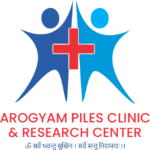Pain during bowel movements can significantly impact one’s quality of life, with one common culprit being anal fissures. These small tears in the lining of the anus can cause severe pain and bleeding. This condition, often explored and treated at the Arogyam Piles Clinic and Research Center in Mohali, Chandigarh, demands a closer look to understand its causes, symptoms, risk factors, and the available treatment options, along with recommended lifestyle changes to manage or prevent it.
Causes of Pain While Passing Stool
The primary cause of pain during defecation is often traced back to anal fissures. These tears are typically the result of passing large or hard stools, which can stretch the anal mucosa beyond its capacity. Other contributing factors may include chronic constipation, diarrhea, or inflammatory conditions affecting the anal area. It’s important to identify the underlying cause to effectively treat and prevent future discomfort.
Understanding Anal Fissures
Anal fissures are characterized by a small cut or a tear in the thin, moist lining of the lower rectum. This condition not only causes significant pain and discomfort during bowel movements but may also lead to spotting or bleeding. While they can be alarming, most fissures are manageable with correct treatment and lifestyle adjustments.
Symptoms of Anal Fissures
Symptoms often include severe pain during and after bowel movements, bleeding from the anus, and possibly the presence of a lump near the anus, which could be a clot or growth. Recognition of these symptoms is crucial in seeking timely medical help and beginning the journey to recovery.
Risk Factors for Anal Fissures
● Chronic constipation or straining during bowel movements.
● Passing hard or large stools.
● Chronic diarrhea.
● Childbirth.
● Inflammatory bowel disease (e.g., Crohn’s disease).
Diagnosis and Treatment Options
Diagnosis of anal fissures usually involves a physical examination by a healthcare provider. Treatment typically begins with conservative measures such as increasing fiber intake, hydration, and employing sitz baths. In more chronic or severe cases, topically applied medications or, rarely, surgical options may be considered. The Arogyam Piles Clinic and Research Center, for instance, offers a range of treatments tailored to the individual’s condition and severity.
Preventive Measures and Lifestyle Changes
To prevent the occurrence or recurrence of anal fissures, adopting certain lifestyle changes is advised. These include maintaining a diet high in fiber, staying well-hydrated, exercising regularly to stimulate bowel movements, and avoiding straining during defecation. Understanding and implementing these measures can significantly reduce the risk of developing painful conditions associated with anal fissures.
In conclusion, while the pain and discomfort associated with passing stool can be daunting, understanding the role of anal fissures in this process is a crucial step towards management and recovery. With appropriate medical guidance and lifestyle adjustments, individuals can alleviate their symptoms and improve their quality of life. The Arogyam Piles Clinic and Research Center continues to provide valuable insights and treatment options for those suffering from this condition.



